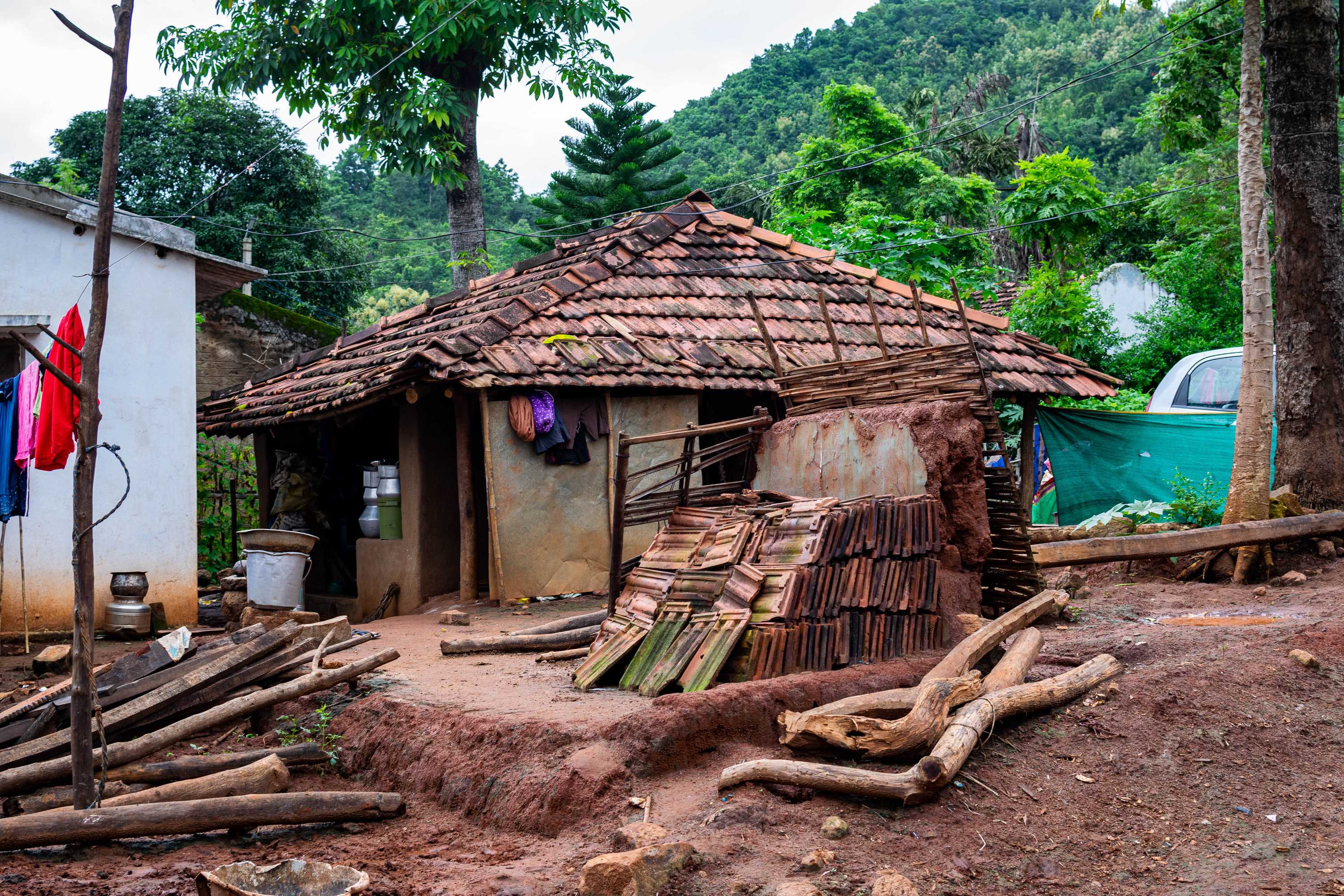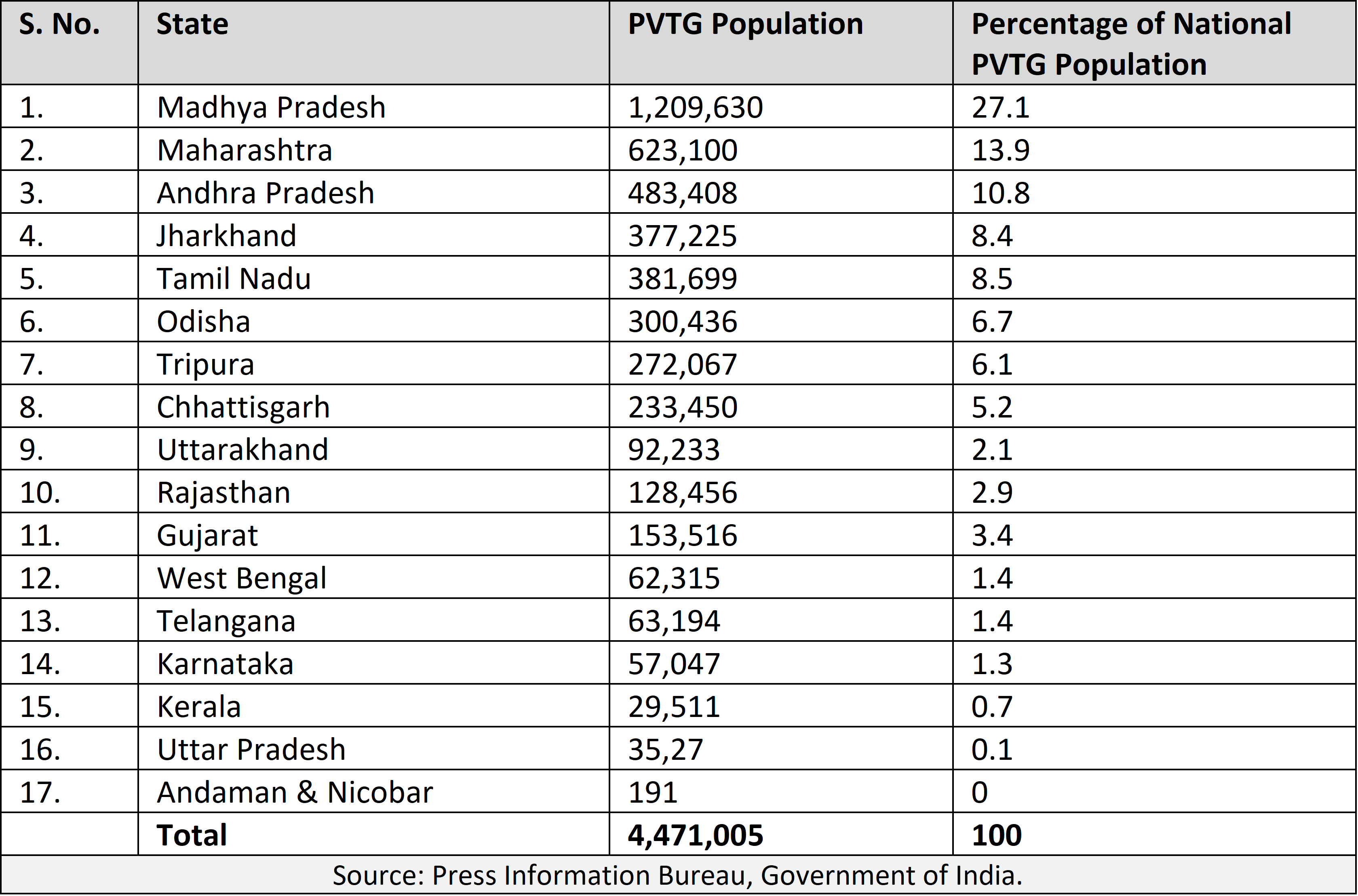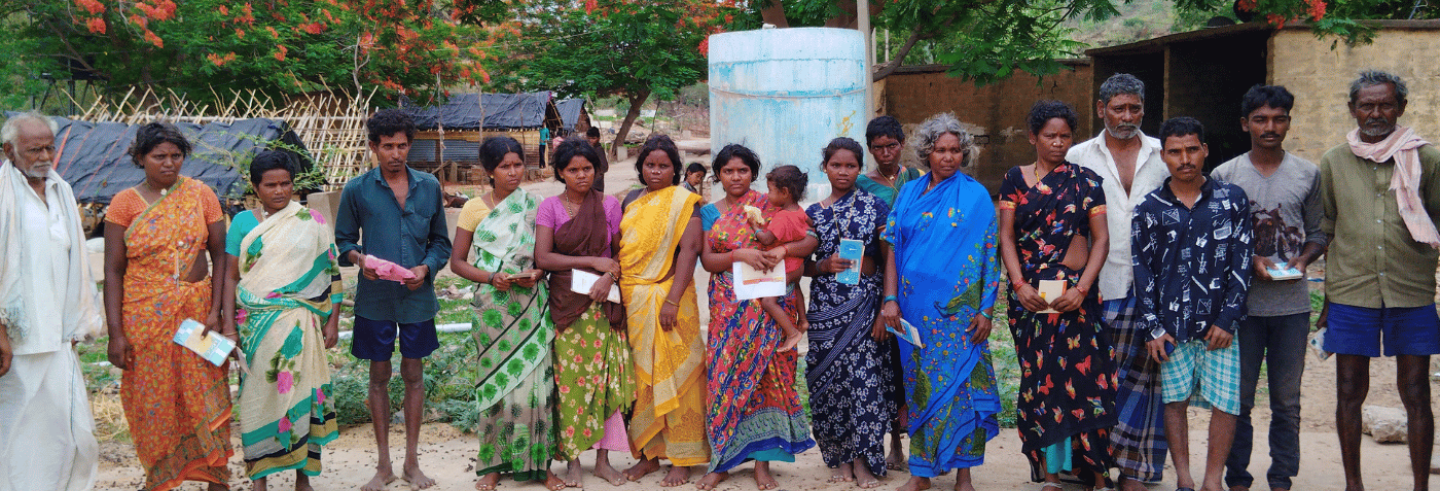Introduction
Gemmeli Sona and Pittalu, a Dhongria Khondh Particularly Vulnerable Tribal Group (PVTG) Adivasi couple from the Alluri Sitharamaraju (ASR) district of Andhra Pradesh, live with their three children in a remote village amidst the Eastern Ghats. The family has been living under the roof of a kutcha (temporary) house for several years. The monsoon poses a significant challenge for them, as heavy rains cause leaks in their roof, and the restrictions imposed by the forest department make it difficult for them to procure bamboo for repairs.
The only option left is to build a new house, which is unaffordable due to the limited and unstable livelihood opportunities available to them in this difficult terrain. Dilapidated and half-constructed houses dot the hills of the Eastern Ghats, especially in PVTG-dominated habitations.
PVTGs represent a subcategory among tribal communities in India. Although the Constitution of India did not initially subcategorise tribal groups, subsequent commissions and studies, such as the Dhebar Commission report of 1961, identified the need to distinguish between different levels of socio-economic development within these communities. This led to the creation of the Primitive Tribal Groups (PTGs) category in 1975, which was renamed PVTGs in 2006, because the term “primitive” was considered derogatory.
According to the Ministry of Tribal Affairs (MoTA), PVTGs constitute the most vulnerable section among tribals and they largely reside in isolated and remote areas in small and scattered hamlets/habitats. In 1975, 52 groups were identified as PVTGs. In 1993, an additional 23 groups were added to the list. PVTGs are found across 18 states and in the Andaman and Nicobar Islands.
According to the Ministry of Tribal Affairs, PVTGs are characterised by the preservation of pre-agricultural practices; a decreasing or stagnant population growth; economic backwardness, and relatively low levels of literacy, even compared to other tribal groups.
The Ministry of Tribal Affairs has acknowledged that even after 75 years of independence, PVTGs continue to face socio-economic vulnerabilities and that development schemes until now have not been able to adequately address their critical infrastructure needs.
Government Initiatives
Acknowledging the backwardness of PVTGs like Sona and Pittalu, governments at various levels have initiated poverty alleviation programmes to uplift them. Since 1975, multiple schemes have been implemented, yet the Conservation-cum-Development (CCD) Plan stands out as the most substantial in terms of budget allocation and coverage. Implemented during the 11th Five-Year Plan period (2007-2012), the CCD Plan was a significant effort spearheaded by the Ministry of Tribal Affairs. Its multifaceted objectives aimed to enhance infrastructure, provide essential amenities, create employment opportunities, eradicate poverty, elevate literacy rates, ensure health and food security, and improve the overall quality of life for PVTG communities.

However, various independent studies on the implementation of CCD Plans show that their success has been limited. The Ministry of Tribal Affairs has also acknowledged that even after 75 years of independence, PVTGs continue to face socio-economic vulnerabilities and that development schemes until now have not been able to adequately address their critical infrastructure needs. Consequently, the launch of the Pradhan Mantri PVTGs Development Mission is an important initiative to address the challenges faced by these groups.
Pradhan Mantri PVTGs Development Mission
During the 2023-24 budget speech, the Finance Minister announced the Pradhan Mantri PVTGs Development Mission with an outlay of Rs. 24,104 crore (central share of Rs. 15,336 crore and state share of Rs. 8,768 crore) for three years under the Development Action Plan for the Scheduled Tribes (DAPST) to enhance the socio-economic conditions of PVTGs. The mission aims to provide essential amenities, road and telecom connectivity, and sustainable livelihoods to all PVTG habitations and households. To implement it, the Pradhan Mantri Janjati Adivasi Nyaya Maha Abhiyan (PM-JANMAN) programme was launched in November 2023 to focus on providing 11 critical interventions through nine ministries to eligible PVTG households and habitations. These include amenities such as housing, electricity, access to drinking water, and so on.
Objectives and Implementation
According to the guidelines released by the Ministry of Tribal Affairs, the PM JANMAN housing scheme aims to provide every PVTG household with access to secure and habitable housing, protecting them from environmental challenges and providing them with a sense of security. The scheme aims to build houses for 4.90 lakh PVTG households by 2026.
Even the existing data on PVTGs raises many questions about its authenticity. For instance, the population of the PVTG group, Jebu Kuruba, in Karnataka was recorded as 6,623 in 1971, but it skyrocketed to an unbelievable 34,747 in 1981.
According to the guidelines, each eligible PVTG household is entitled to receive Rs. 2.39 lakh for the construction of a pucca (permanent) house. This amount includes Rs. 2 lakh as the unit cost of the house, Rs. 12,000 for toilet construction in convergence with the Swachh Bharat Mission (Gramin), and approximately Rs. 27,000 for 90-95 days of unskilled wages under the Mahatma Gandhi National Rural Employment Guarantee Act (MGNREGA), thereby making it mandatory to possess an MGNREGA job card.
Under the intervention, states are required to register eligible PVTG households for the scheme. They are to upload the mandatory gram sabha resolutions after job card and Aadhaar verification, and to geo-tag the site for house construction. They are then required to sanction housing benefits for eligible PVTG households within the quota approved by the union government. A fundamental requisite of the scheme involves the estimation of the number of PVTG households—a process fraught with challenges.
Population Estimation
The allocation of funds for any scheme or programme depends on the entitlements and the constituency of “entitlement holders”, whose numbers must be known. In the case of PM JANMAN housing, where benefits are distributed at the household level, having accurate data on entitlement holders is crucial. Unfortunately, the housing intervention falls short on this.
In response to a question in the Rajya Sabha in 2022, the Ministry of Tribal Affairs stated that the census does not collect specific data on PVTGs. Only tribes notified as Scheduled Tribes (STs) are enumerated separately. Consequently, no exclusive and centralised data exists on PVTGs, leading to questions about the reliability of the cited population figures. However, some state and union territory-wise decadal data on PVTGs is available from the Registrar General of India.
Even the existing data on PVTGs raises many questions about its authenticity. For instance, the population of the PVTG group, Jebu Kuruba, in Karnataka was recorded as 6,623 in 1971, but it skyrocketed to an unbelievable 34,747 in 1981. Misra in The Particularly Vulnerable Tribal Groups in India: Privileges and Predicaments (2016) suggests a possible explanation—other groups may have claimed to be Jebu Kurubas, resulting in inflated numbers.
When the PM JANMAN programme was announced in November 2023, the population of PVTGs in the country was estimated at 28 lakh, based on surveys. This number was revised upwards to 36.75 lakh in mid-January 2024 and 44.71 lakh in July 2024 (Table 1). Further, there is a dissonance between the estimated population figures of the union government and state governments concerned. For instance, as per the minutes of a national-level meeting held on 15 November 2023, the Ministry of Tribal Affairs has identified only 3,500 PVTG households in the state of Jharkhand while the state government figure stood at 70,000. On 14 November 2023, the ministry claimed the number of PVTG habitations to be 22,000, but this was subsequently revised to 30,000 by 8 March 2024.
Table 1: State-wise Estimated PVTG Population (as on 20 July 2024)

To estimate the PVTG population, the union government relied on data from the PM Gati-Shakti portal, an integrated infrastructure planning platform aimed at improving coordination and implementation of infrastructure projects across India, updated by state governments. However, the primary limitation of the data collection process through the PM Gati-Shakti portal is the absence of a household-level survey, specifically for PVTGs. Instead, the portal identifies PVTG habitations and estimates the number of households within these habitations. Media reports indicate that the methods used to estimate the PVTG population varied even among the districts of Jharkhand and Chhattisgarh.
More importantly, issues such as the lack of infrastructure and common surnames shared by PVTG and non-PVTG individuals make population enumeration a challenging task for officials in tribal areas. In this context, gram sabhas play an important role in collecting accurate data on PVTG populations and households. However, our observations on the ground indicate that gram sabhas were not consulted on this matter.
The lack of reliable data on PVTGs has been identified by scholars as a significant factor contributing to the shortcomings of schemes to uplift them (Saxena and Saxena 2014). In this context, it is prudent to expect the Ministry of Tribal Affairs to allocate more time and resources to data collection for the scheme this time. However, these concerns have not been fully addressed. It remains unclear whether this oversight was due to the urgency of implementing the scheme before the general elections or other administrative challenges.
Budget Considerations
At the launch of the PM JANMAN programme in November 2023, the estimated PVTG population in the country was around 28 lakh. Based on this population figure, the union government earmarked Rs. 10,000 crore for constructing 4.9 lakh houses by 2026 under the PM JANMAN housing scheme. However, as of July 2024, the estimated PVTG population has increased to 44.7 lakh—a substantial 60% rise. Despite this significant increase in the estimated PVTG population, the targeted number of houses to be constructed and the subsequent budget allocation under the PM JANMAN housing scheme were not revised in either the Interim Budget (February 2024) or the 2024-25 Union Budget.
The union government’s share in the allocated Rs. 10,000 crore is only Rs. 6,200 crore, while the states are responsible for covering the remaining Rs. 3,700 crore. This poses a significant disincentive for financially strained states.
This highlights the shortcomings in addressing the needs of the growing PVTG population. Even to accommodate all 10.7 lakh estimated PVTG households in November 2023, the estimated budget for the housing scheme would need to increase to Rs. 25,600 crore, significantly surpassing the total allocation of Rs. 25,000 crore across 11 schemes under the entire PM JANMAN. It is important to note that the budget would further increase significantly if we consider the latest estimation figures. Further, the union government’s share in the allocated Rs. 10,000 crore is only Rs. 6,200 crore, while the states are responsible for covering the remaining Rs. 3,700 crore. This poses a significant disincentive for financially strained states.
Additionally, we realised that the allocated amount of Rs. 2.39 lakh is insufficient to construct a house with adequate space for a family to lead a dignified life. The Rural Development Trust (RDT), a non-governmental organisation, has been actively involved in building houses for poor households in Andhra Pradesh for a long time. They are constructing homes for Chenchus (PVTG) in and around the Nallamala Hills of Andhra Pradesh and spend approximately Rs. 5.80 lakh to build a house with a toilet for a family of four.
The PM JANMAN scheme falls short in providing sufficient funds to construct a house. In our interviews with more than 100 Chenchu households, all said that the money given under JANMAN is not enough to build a house. They are requesting the RDT for help in both adding the deficit amount and assisting them in building houses because they lack the necessary knowledge for construction.
PM JANMAN Rollout
States were required to conduct surveys and register eligible PVTG households by a specified deadline. The survey process began on 15 December 2023 and had to be completed by 5 January 2024. From the above discussion, it is apparent that the scheme has been rolled out without fully addressing the challenges involved in working with PVTGs.
Korra Rasmo, a PVTG member from the Alluri Sitharamaraju district in Andhra Pradesh, was one of the few fortunate PM JANMAN entitlement holders who got a chance to interact with the Prime Minister on 15 January 2024 via a video conference. Rasmo was hastily registered for the housing scheme by the local administration just before this interaction. Subsequently, she received her first instalment of Rs. 50,000 in her bank account.
The current implementation framework shows a disconnect between policy design and ground realities, which were exacerbated by the urgency to roll out the scheme before elections.
According to the scheme guidelines, all three instalments should be transferred to beneficiaries within three months, with each instalment credited after the completion of specific construction milestones. However, Rasmo continues to wait for further instalments even after five months and has been unable to begin construction. Local officials have advised her not to start construction as they themselves are unclear about the scheme’s guidelines. We found several such cases during our fieldwork.
Conclusion and Recommendations
The implementation of the PM JANMAN housing scheme for PVTGs reveals significant challenges that must be addressed to achieve its intended goals. Despite the scheme’s potential to alleviate multidimensional poverty and improve living conditions, its success largely depends on accurate data collection, realistic budget allocations, and effective community involvement. The discrepancies in population estimates and budget constraints highlight the need for a more nuanced and well-planned approach.
The historical neglect of PVTGs underscores the importance of tailored interventions that go beyond mere allocations to ensure sustainable development. The current implementation framework shows a disconnect between policy design and ground realities, which were exacerbated by the urgency to roll out the scheme before elections.
To truly uplift PVTGs, it is imperative to address the inaccuracies in data collection, ensure equitable budget allocations that account for logistical challenges, and involve local communities in the decision-making process. Only through a concerted effort that bridges the gap between promise and practice can the PM JANMAN housing scheme fulfil its objective of providing secure and habitable housing for the most vulnerable tribal communities in India.
To enhance the efficacy of the mission, we recommend the following.
1. Involve gram sabhas actively in identifying eligible entitlement holders and also in distributing cash benefits to them.
2. Invest in comprehensive training for enumerators and use robust, user-friendly digital tools to ensure accurate data collection.
3. Adjust the budget in line with updated population figures and ensure sufficient funding for the housing intervention.
4. Increase the budget allocation for one housing unit, considering local needs.
5. Involve local non-governmental organisations (NGOs) and community organisations in the implementation process to ensure better reach and efficacy.
6. Allow for flexibility in the guidelines to accommodate the unique challenges of different regions and communities.
7. Foster better coordination between state and central governments to address issues such as land acquisition and integration of additional villages.
8. Ensure that funds and benefits are disbursed in a timely and transparent manner, avoiding political interference.
By implementing these recommendations, the PM JANMAN housing scheme could achieve its goals more effectively, providing lasting benefits to PVTG communities and sustainably improving their living conditions.
Chakradhar Buddha and Rahul Mukkera are with LibTech India, an organisation focused on improving transparency, accountability, and democratic engagement in public service delivery.











